The Golden Age of the 1940s |
 |
One of my favourite eras is the 1940s. Although dominated by the horrors of war, Hollywood produced some of its best films during this period. The glamour of the late forties and early fifties portrayed by "wise-cracking dames" and "tough, lovable guys" showed the coming of age of cinema.The music of the forties for me means jazz, rythm and blues.Fashion in the forties was varied from rationing and hard times during the war, which forced women to paint seams on the back of their legs to give the impression that they were wearing tights, to the glamour of the New Look in 1947.
Films of the 1940s
 |
"To
Have or Have Not" Dir:Howard Hawks 1944 Bogey and Bacall were perhaps the most famous of all Hollywood couplings and this 1940s classic unites the two.The interplay between the central characters is electric and some of the lines are delivered so naturally that it seems they ad-libbed their way through the film.Possibly not as polished as "The Big Sleep" and although the plot is not as intriguing, fine performances from the two leads ensure you won't be able to leave until the final credits roll. |
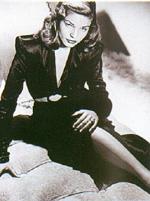 |
"The Big Sleep" Dir: Howard Hawks 1946 One of Bogart's best.He is a Private Investigator called in by an infirm old man to sort out the problems his younger daughter is having with bad gambling debts.Lauren Bacall stars as the older sister, a little more world wise but nonetheless embroiled in shady dealings. |
 |
"Double Indemnity" Dir: Billy Wilder 1944 Starring Barbara Stanwyck and Fred MacMurray this film tells the tale of one woman's powerful seduction of a man which drives him to carry out the ultimate act for her.It keeps you guessing until the very end |
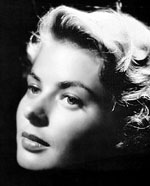 |
"Casablanca" Dir:Michael Curtiz 1942 Ingrid Bergman and Humphrey Bogart starred in "Casablanca". Everyone knows this one and can quote the famous lines like Rick's "Of all the bars in all the world you had to walk into mine" and "Play it Sam". A great film which will never date. |
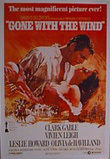 |
"Gone with the Wind"
1939 One of the most important films of all time."Titanic" may have beaten it at the box office but it doesn't compare to this all time classic epic.At over three hours it won 8 Oscars and is still popular today. |
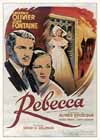 |
"Rebecca" Dir: Alfred Hitchcock 1940 This film has haunted me from the moment I saw it as a child. The image of Mandalay going up in smoke with Mrs. Danvers standing at the window is terrifying and Laurence Olivier and Joan Fontaine star. |
Music in the 1940s
Along with great films there was
also great music and the Glenn Miller Orchestra was one of the
most famous, entertaining the troops during the war years.
Jazz and blues came into its own and from the
forties onwards musicians such as Miles Davis, Charlie Parker and
great female vocalists like Ella Fitzgerald, Nina Simone and
Billie Haliday entertained audiences both black and white alike.
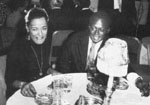 |
Billie Haliday and Miles Davis having dinner together.Not necessarily all from the forties, these artists did however have their roots there.Nina Simone and Billie Haliday sang about love and loss and both had quite sad lives. Nina Simone's song entitled "Strange Fruit" laments the hanging of black people by the Ku Klux Klan and much of her later life was dominated by political issues. |
 |
Ella Fitzgerald is one of my all time favourite singers.Born April 25th 1918 Ella joined Chuck Webb at the age of sixteen as vocalist and became an instant hit with jazz fans.After Webb's death in 1939 she went solo and had numerous hits during the 40's and 50's such as "Making Whoopee","How High the Moon " and "Sentimental Journey". |
Fashion in the 1940s
The epitomy of style and elegance |
The New Look
- Women's Fashions of the 1940s Silhouette
Fabrics Available Popular Colors and Prints
Hemlines Day and Night The Latest Fads |
Events of the 1940s